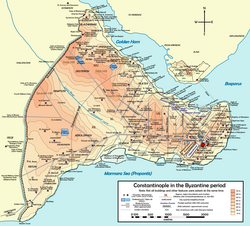
Back حصار القسطنطينية (1203) Arabic Аблога Канстанцінопаля (1203) Byelorussian Setge de Constantinoble (1203) Catalan Πολιορκία της Κωνσταντινούπολης (1203) Greek Sitio de Constantinopla (1203) Spanish محاصره قسطنطنیه (۱۲۰۳) Persian Siège de Constantinople (1203) French Կոստանդնուպոլսի պաշարում (1203) Armenian Կոստանդնուպոլսոյ Պաշարում (1203) HYW Pengepungan Konstantinopel (1203) ID
This article needs additional citations for verification. (December 2008) |
| Siege of Constantinople | |||||||
|---|---|---|---|---|---|---|---|
| Part of the Fourth Crusade | |||||||
 Map of Constantinople during the Byzantine era | |||||||
| |||||||
| Belligerents | |||||||
|
Fourth Crusade loyalist of Alexios IV Angelos | Byzantine Empire | ||||||
| Commanders and leaders | |||||||
|
Boniface I Enrico Dandolo | Alexios III Angelos | ||||||
| Strength | |||||||
|
Crusaders: 10,000 men[1] Venetians: 10,000 men[1] and 210 ships[2] | 15,000 men[3] and 20 ships[4] | ||||||
The siege of Constantinople in 1203 was a crucial episode of the Fourth Crusade, marking the beginning of a series of events that would ultimately lead to the fall of the Byzantine capital. The crusaders, diverted from their original mission to reclaim Jerusalem, found themselves in Constantinople, in support of the deposed emperor Isaac II Angelos and his son Alexios IV Angelos. The besieging forces, primarily composed of Western European knights faced initial setbacks, but their determination and advanced siege weaponry played a pivotal role in pressuring the Byzantine defenders.
Amidst the chaos, the Byzantine emperor was overthrown, leading to a power vacuum and setting the stage for the more infamous events of 1204 when the crusaders, frustrated by unpaid debts and political turmoil, eventually sacked the city. This marked the first time in nearly nine centuries that Constantinople fell to an external force, forever altering the course of Byzantine history.